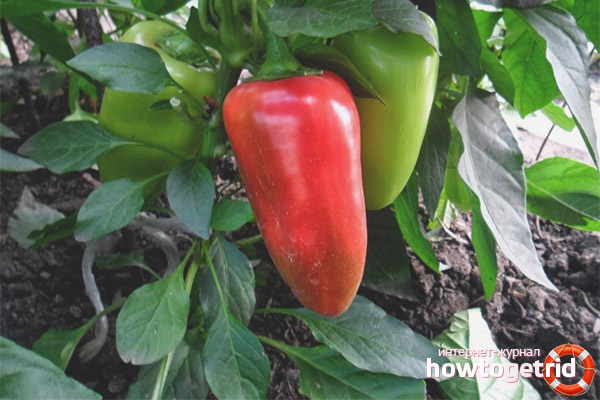The content of the article
The merchant is an early ripe, productive grade of bell pepper. The fruits are in the shape of a pyramid. From the emergence of seedlings to harvest takes about 100 days. The bush is medium height, up to 85 cm. The leaves are dark green. The root system is superficial.
Grade description
This variety tolerates short-term temperature drops well. The fruits contain a whole range of beneficial substances, including carotenoids. Variety Merchant is good in canned form, it is used for cooking lecho, stuffed, it is also very good in freezing.
Growing pepper seedlings
To grow a large crop of bell pepper, you will have to take care of growing high-quality, healthy seedlings. Pepper seeds are planted in March in pre-prepared soil. Buy seed only from trusted suppliers in seed stores.
- The soil mixture can be prepared independently from black soil, peat and river sand. The soil should be porous, light and fertile. Before sowing seeds, you need to freeze the soil or treat with fungicide.
- Seeding is carried out to a depth of 1-2 cm. It is not necessary to deepen the seeds too deep, germination is delayed from this.
- The optimum temperature for the germination of pepper seeds is 22-24 degrees. The first shoots should appear 5-7 days after planting in the ground. In the early stages of germination, the presence of sunlight is optional, only heat and moisture are sufficient. But after the appearance of the first shoots, boxes with seedlings need to be transferred to a lighted place.
- At the end of February and the beginning of March, the daylight is not long enough; young plants will not get light that is so necessary for the normal growth and development of plants. Seedlings need additional illumination with artificial light (phytolamps). Highlight seedlings daily in the morning and evening for 2-3 hours.
- Bell pepper is a heat-loving culture that does not tolerate drafts and lower temperatures below 5 degrees. You need to water the seedlings with warm water, spraying it from the spray gun. At the age of 3-4 weeks, seedlings are fed with complex fertilizers. Pepper is very responsive to organics.
- If you plan to grow seedlings in open ground, two weeks before planting, you need to start hardening it. Take the plants out onto the balcony for 2 hours daily.
- At the age of 2-3 weeks, seedlings need to be peaked in separate pots or peat tablets. If you leave the plants to grow in one box, they will begin to stretch, turn yellow. From such seedlings you can’t get strong, productive bushes.
A common mistake of beginning gardeners is the desire to sow pepper as soon as possible in order to get an early harvest. This is not the right approach, the optimal time for sowing seeds is the first half of March.
Landing
Seedlings begin to be planted in open ground when steady warm weather sets in, usually in late May - early June.
- Pepper does not tolerate transplanting, not like tomatoes. You need to get the plant out of the pot very carefully, together with a lump of earth. The height of the seedlings should be 20-25 cm. The plants should have 6-8 leaves, several flower buds are allowed.
- Sometimes, due to improper conditions for growing seedlings, flowers and ovaries appear on the plants until they are planted in open ground. Such flowers and ovaries need to be removed. They formed due to the fact that there was little space in the pot.
- Add peat, humus, a little ash to the planting holes, moisten the soil with plenty of water. Do not bury the plant in the ground above the cotyledon leaves.Some novice gardeners try to bury the seedlings as deep as possible, they think that additional roots are formed on the trunk, thanks to which the plant will begin to receive more nutrition. This opinion is erroneous; pepper does not form additional stems above the cotyledon leaves.
- Planted plants need to be pritenit for a while and protected from gusts of wind. Temporary shelters in 1-2 weeks can be removed.
The soil under the bushes and in the aisles is mulched with sawdust or mowed grass. Mulching allows you to save precious moisture in the upper layers of the soil. Also under the layer of mulch, earthworms are activated, which contribute to the saturation of the soil with oxygen.
Bell Pepper Care
Pepper is responsive to fertilizing with organic fertilizers, for example, herbal infusion. An infusion of grass can be prepared with your own hands. To do this, mowed grass is placed in a deep container, poured with warm water and left to ferment for 14 days. Fermented slurry must be filtered through burlap, diluted with water and poured Bulgarian pepper under the root with this solution.
- Pepper does not tolerate waterlogging of the soil, due to excess moisture, the root system rots.
- Do not plant plants too close together. With thickened plantings, the risk of fungal diseases, rot increases.
- Remember to shape the plant. Excessive growth of lateral shoots should not be allowed. It is necessary to timely remove fatlique stepchildren and lower leaves that are in contact with the ground.
- If you grow pepper Merchant in a greenhouse, then remember that at a temperature of 35 degrees and above the ovary ceases to form on the plants. This is due to the fact that pollen becomes sterile at high temperatures, fertilization does not occur. Take care of organizing the ventilation of greenhouses.
- The fruits of this variety ripen in waves, therefore, in order to accelerate the emergence of new ovaries, the fruits are ripped off in a state of technical ripeness, without waiting for their full biological ripening.
Variety Merchant tolerates short-term temperature drops. He is very unpretentious in growing. A complex of useful substances accumulates in its fruits.
Video: pepper Merchant










Submit